Biomechanics of Sport and Exercise: Drop Jump Landing Analysis Report
VerifiedAdded on 2022/11/24
|9
|2185
|441
Report
AI Summary
This laboratory report investigates the biomechanics of drop jumps from two different heights (30cm and 60cm) to analyze the landing process. The study focuses on collecting, processing, and managing kinematic and kinetic data, particularly ground reaction forces (GRF). The analysis includes regression analysis to determine the relationship between variables like force and time. The findings reveal that both the peak and mean values of the ground reaction force increase with increasing drop height. A literature review supports the research, referencing studies on ACL injuries, drop jump variations, and the influence of footwear. The report also discusses the limitations of biomechanical approaches, such as the potential for injury during experimentation and mechanical constraints. The conclusion emphasizes the correlation between drop height and force/time variables, highlighting the importance of understanding these relationships for injury prevention and performance enhancement. The report uses the collected data to determine the relationship between variables and how they affect each other. The report also highlights the limitations of biomechanical approaches and the significance of the study for sports and exercise science.
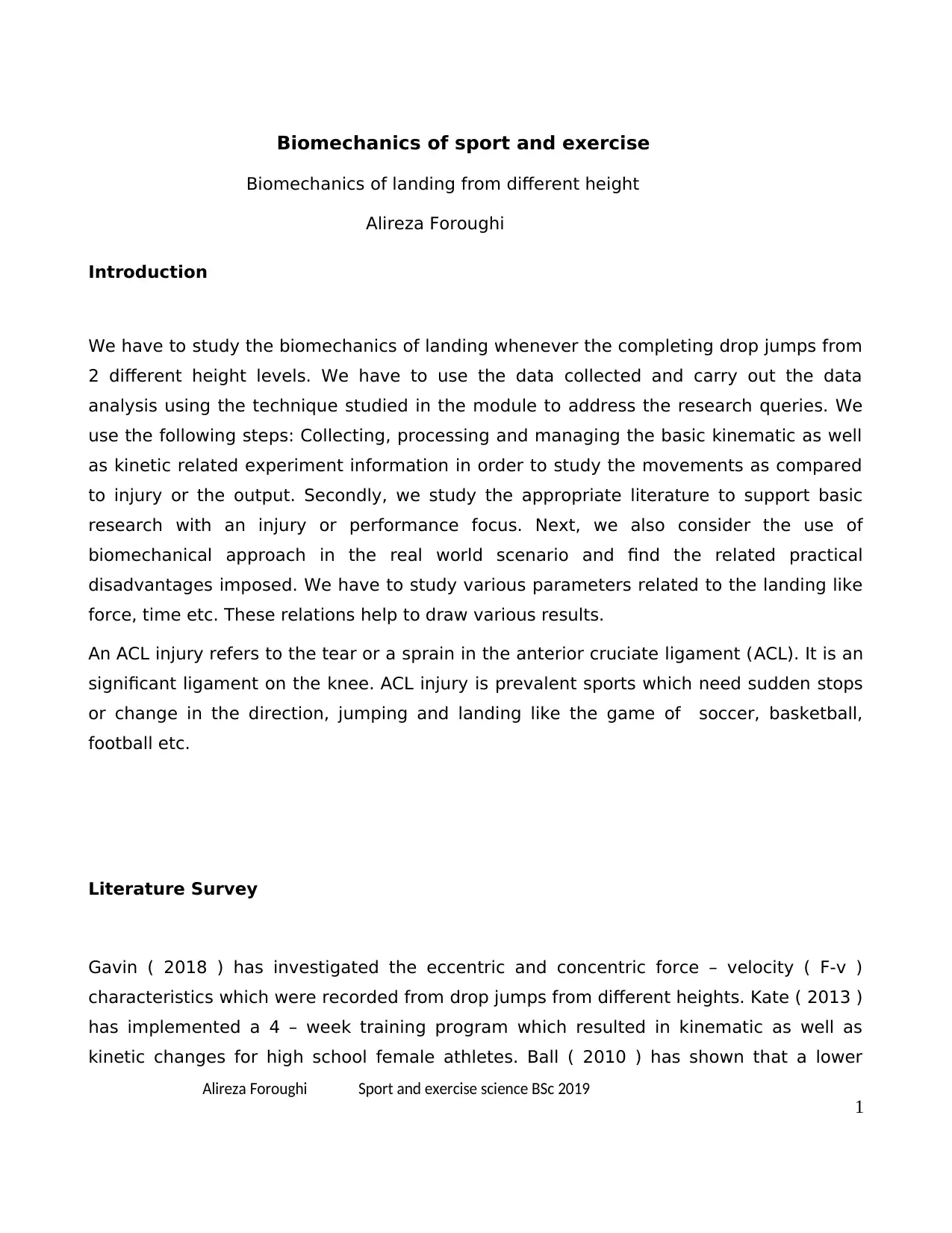
Biomechanics of sport and exercise
Biomechanics of landing from different height
Alireza Foroughi
Introduction
We have to study the biomechanics of landing whenever the completing drop jumps from
2 different height levels. We have to use the data collected and carry out the data
analysis using the technique studied in the module to address the research queries. We
use the following steps: Collecting, processing and managing the basic kinematic as well
as kinetic related experiment information in order to study the movements as compared
to injury or the output. Secondly, we study the appropriate literature to support basic
research with an injury or performance focus. Next, we also consider the use of
biomechanical approach in the real world scenario and find the related practical
disadvantages imposed. We have to study various parameters related to the landing like
force, time etc. These relations help to draw various results.
An ACL injury refers to the tear or a sprain in the anterior cruciate ligament (ACL). It is an
significant ligament on the knee. ACL injury is prevalent sports which need sudden stops
or change in the direction, jumping and landing like the game of soccer, basketball,
football etc.
Literature Survey
Gavin ( 2018 ) has investigated the eccentric and concentric force – velocity ( F-v )
characteristics which were recorded from drop jumps from different heights. Kate ( 2013 )
has implemented a 4 – week training program which resulted in kinematic as well as
kinetic changes for high school female athletes. Ball ( 2010 ) has shown that a lower
Alireza Foroughi Sport and exercise science BSc 2019
1
Biomechanics of landing from different height
Alireza Foroughi
Introduction
We have to study the biomechanics of landing whenever the completing drop jumps from
2 different height levels. We have to use the data collected and carry out the data
analysis using the technique studied in the module to address the research queries. We
use the following steps: Collecting, processing and managing the basic kinematic as well
as kinetic related experiment information in order to study the movements as compared
to injury or the output. Secondly, we study the appropriate literature to support basic
research with an injury or performance focus. Next, we also consider the use of
biomechanical approach in the real world scenario and find the related practical
disadvantages imposed. We have to study various parameters related to the landing like
force, time etc. These relations help to draw various results.
An ACL injury refers to the tear or a sprain in the anterior cruciate ligament (ACL). It is an
significant ligament on the knee. ACL injury is prevalent sports which need sudden stops
or change in the direction, jumping and landing like the game of soccer, basketball,
football etc.
Literature Survey
Gavin ( 2018 ) has investigated the eccentric and concentric force – velocity ( F-v )
characteristics which were recorded from drop jumps from different heights. Kate ( 2013 )
has implemented a 4 – week training program which resulted in kinematic as well as
kinetic changes for high school female athletes. Ball ( 2010 ) has shown that a lower
Alireza Foroughi Sport and exercise science BSc 2019
1
Paraphrase This Document
Need a fresh take? Get an instant paraphrase of this document with our AI Paraphraser

height drop jump causes an asymmetrical bilateral training stimulus and a higher height
drop jump does not. This can be helpful for designing the protocols for training of
athletes. Tyler ( 2019 ) has shown that drop landing is not the best choice to analyse the
landing biomechanics. Howe ( 2018 ) has done a study of reliability for peak vertical
ground reaction force ( vGRF ), time to peak vGRF and loading rate during the drop –
landing task ( for unilateral as well as bilateral ).
Sinclair ( 2015 ) has suggested that while doing plyometric training, minimalist footwear
must be used by the people who are prone to pain of knee. Louis ( 2019 ) has
investigated the relation between the ankle dorsiflexion range of motion ( DF ROM ) and
kinetic as well as kinematic variables which are measured during the drop – landing
( bilateral ) from different percentages of jumping height. Hayley ( 2016 ) has interpreted
that there occur some biomechanical changes after a 4- week feedback intervention in
the athletic tasks.
Adam ( 2015 ) has shown that the participants with Patellar tendinopathy ( PT ) showed
lesser maximum flexion as well as angular displacement in the sagittal plane ( at the
knee as well as the hip ). Shen Zhang ( 2019 ) has studied the biomechanical difference
between the drop jump ( anticipated ) and the drop landing ( unanticipated ). Michael
( 2003 ) has shown that the females must land in an erect position in order to maximize
the absorption of energy from the joints which are in maximum proximity to the ground
contact. Boyi Dai ( 2016 ) has studied the effect of the jump height, speed and cutting
speed on the biomechanics ( lower extremity ).
Chaudhari (2008) has studied the method of starting of osteoarthritis after anterior
cruciate ligament (ACL) injury. The ambulatory changes after an ACL injury, cartilage
adaptation to the load, and the relation between the cartilage loads during a walk and
changes in the cartilage structure as well as biology are studied. It has been shown that
the cartilage degeneration post the ACL injury may be due to a kinematic gait change
which can shift the ambulatory load applied to the cartilage. The method shows that the
ACL injury model can be employed to study the relation between the mechanics and
biology and also explain the significance of restoring normal ambulatory kinematics after
ACL injury to prevent premature osteoarthritis.
Alireza Foroughi Sport and exercise science BSc 2019
2
drop jump does not. This can be helpful for designing the protocols for training of
athletes. Tyler ( 2019 ) has shown that drop landing is not the best choice to analyse the
landing biomechanics. Howe ( 2018 ) has done a study of reliability for peak vertical
ground reaction force ( vGRF ), time to peak vGRF and loading rate during the drop –
landing task ( for unilateral as well as bilateral ).
Sinclair ( 2015 ) has suggested that while doing plyometric training, minimalist footwear
must be used by the people who are prone to pain of knee. Louis ( 2019 ) has
investigated the relation between the ankle dorsiflexion range of motion ( DF ROM ) and
kinetic as well as kinematic variables which are measured during the drop – landing
( bilateral ) from different percentages of jumping height. Hayley ( 2016 ) has interpreted
that there occur some biomechanical changes after a 4- week feedback intervention in
the athletic tasks.
Adam ( 2015 ) has shown that the participants with Patellar tendinopathy ( PT ) showed
lesser maximum flexion as well as angular displacement in the sagittal plane ( at the
knee as well as the hip ). Shen Zhang ( 2019 ) has studied the biomechanical difference
between the drop jump ( anticipated ) and the drop landing ( unanticipated ). Michael
( 2003 ) has shown that the females must land in an erect position in order to maximize
the absorption of energy from the joints which are in maximum proximity to the ground
contact. Boyi Dai ( 2016 ) has studied the effect of the jump height, speed and cutting
speed on the biomechanics ( lower extremity ).
Chaudhari (2008) has studied the method of starting of osteoarthritis after anterior
cruciate ligament (ACL) injury. The ambulatory changes after an ACL injury, cartilage
adaptation to the load, and the relation between the cartilage loads during a walk and
changes in the cartilage structure as well as biology are studied. It has been shown that
the cartilage degeneration post the ACL injury may be due to a kinematic gait change
which can shift the ambulatory load applied to the cartilage. The method shows that the
ACL injury model can be employed to study the relation between the mechanics and
biology and also explain the significance of restoring normal ambulatory kinematics after
ACL injury to prevent premature osteoarthritis.
Alireza Foroughi Sport and exercise science BSc 2019
2
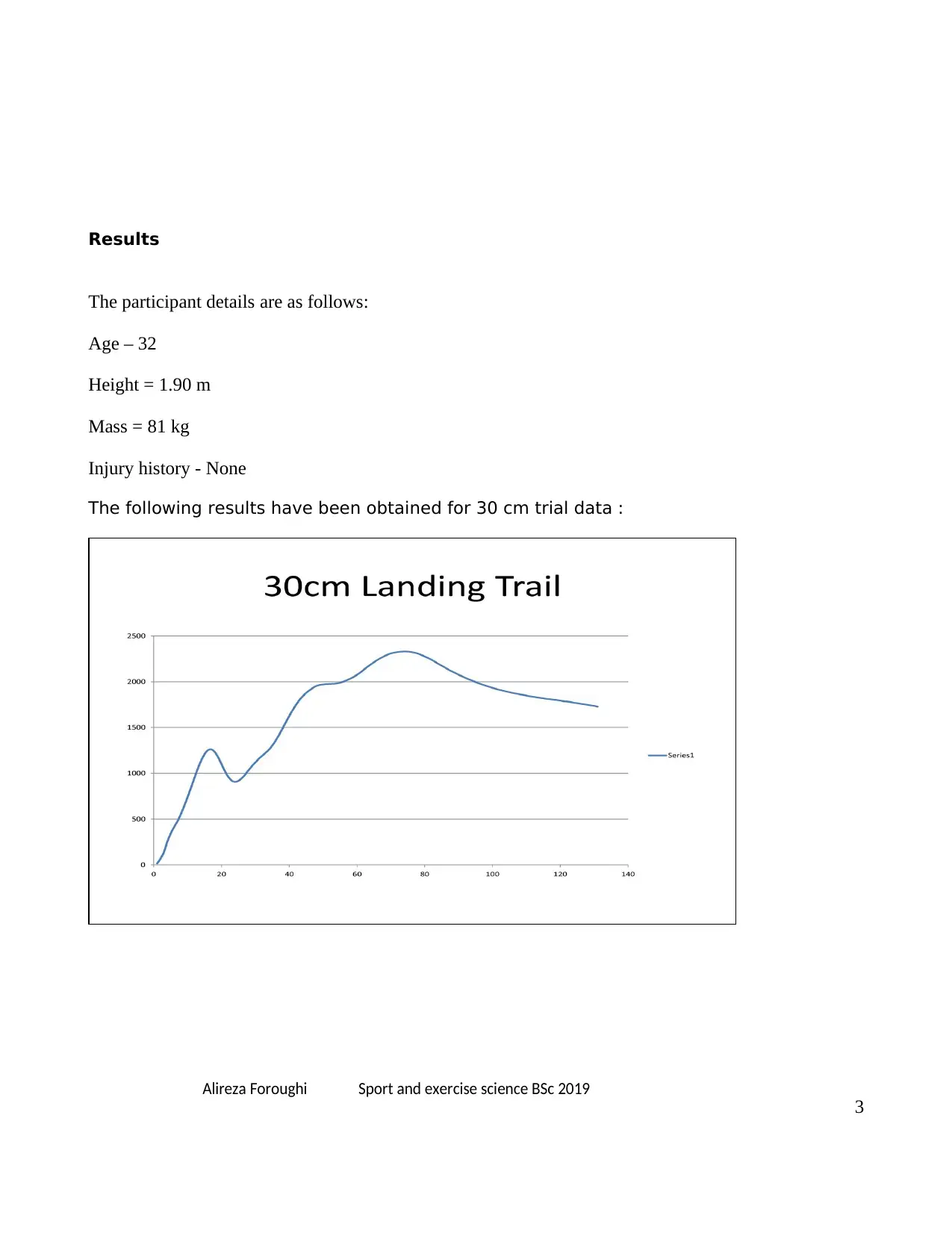
Results
The participant details are as follows:
Age – 32
Height = 1.90 m
Mass = 81 kg
Injury history - None
The following results have been obtained for 30 cm trial data :
Alireza Foroughi Sport and exercise science BSc 2019
3
The participant details are as follows:
Age – 32
Height = 1.90 m
Mass = 81 kg
Injury history - None
The following results have been obtained for 30 cm trial data :
Alireza Foroughi Sport and exercise science BSc 2019
3
⊘ This is a preview!⊘
Do you want full access?
Subscribe today to unlock all pages.

Trusted by 1+ million students worldwide
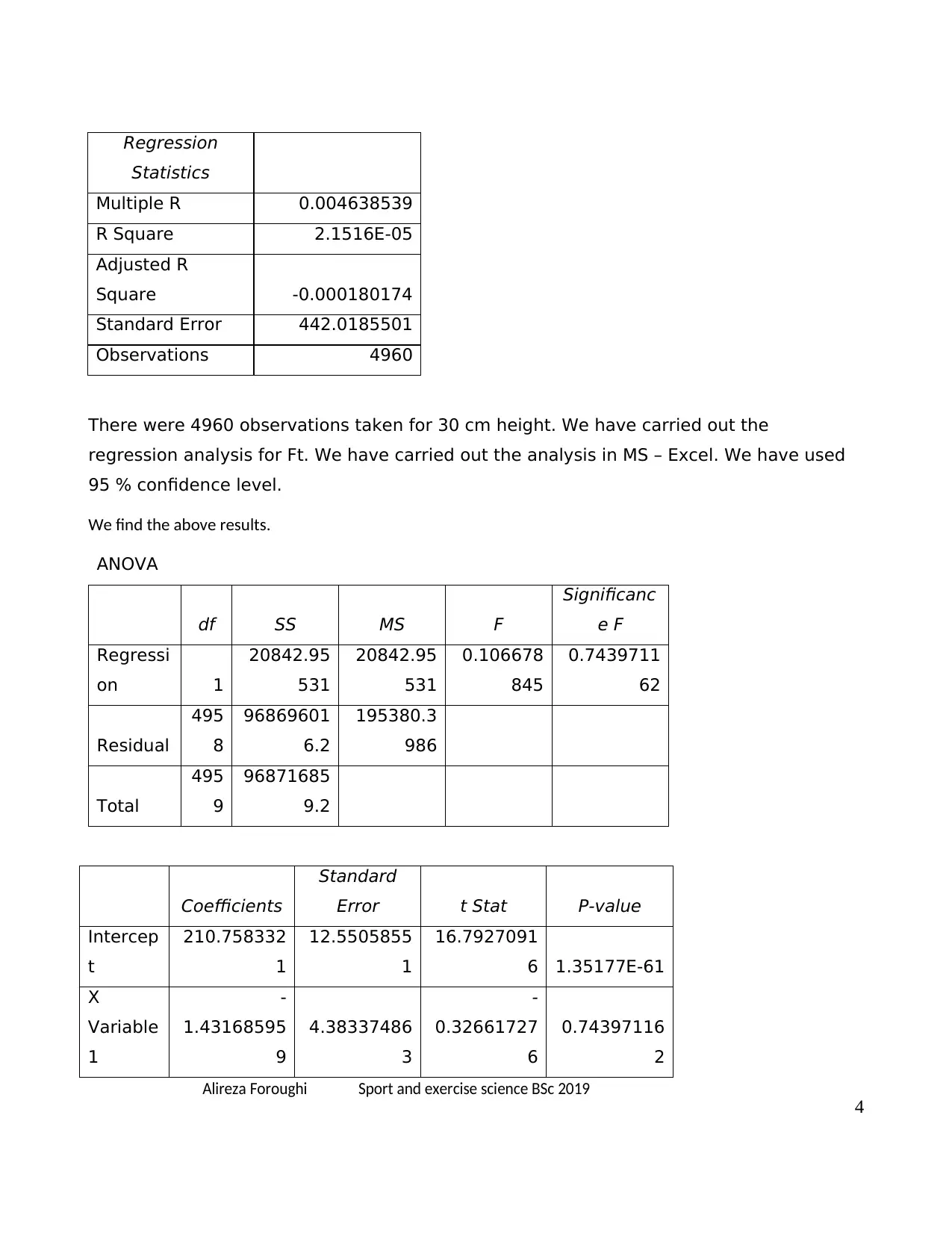
Regression
Statistics
Multiple R 0.004638539
R Square 2.1516E-05
Adjusted R
Square -0.000180174
Standard Error 442.0185501
Observations 4960
There were 4960 observations taken for 30 cm height. We have carried out the
regression analysis for Ft. We have carried out the analysis in MS – Excel. We have used
95 % confidence level.
We find the above results.
ANOVA
df SS MS F
Significanc
e F
Regressi
on 1
20842.95
531
20842.95
531
0.106678
845
0.7439711
62
Residual
495
8
96869601
6.2
195380.3
986
Total
495
9
96871685
9.2
Coefficients
Standard
Error t Stat P-value
Intercep
t
210.758332
1
12.5505855
1
16.7927091
6 1.35177E-61
X
Variable
1
-
1.43168595
9
4.38337486
3
-
0.32661727
6
0.74397116
2
Alireza Foroughi Sport and exercise science BSc 2019
4
Statistics
Multiple R 0.004638539
R Square 2.1516E-05
Adjusted R
Square -0.000180174
Standard Error 442.0185501
Observations 4960
There were 4960 observations taken for 30 cm height. We have carried out the
regression analysis for Ft. We have carried out the analysis in MS – Excel. We have used
95 % confidence level.
We find the above results.
ANOVA
df SS MS F
Significanc
e F
Regressi
on 1
20842.95
531
20842.95
531
0.106678
845
0.7439711
62
Residual
495
8
96869601
6.2
195380.3
986
Total
495
9
96871685
9.2
Coefficients
Standard
Error t Stat P-value
Intercep
t
210.758332
1
12.5505855
1
16.7927091
6 1.35177E-61
X
Variable
1
-
1.43168595
9
4.38337486
3
-
0.32661727
6
0.74397116
2
Alireza Foroughi Sport and exercise science BSc 2019
4
Paraphrase This Document
Need a fresh take? Get an instant paraphrase of this document with our AI Paraphraser
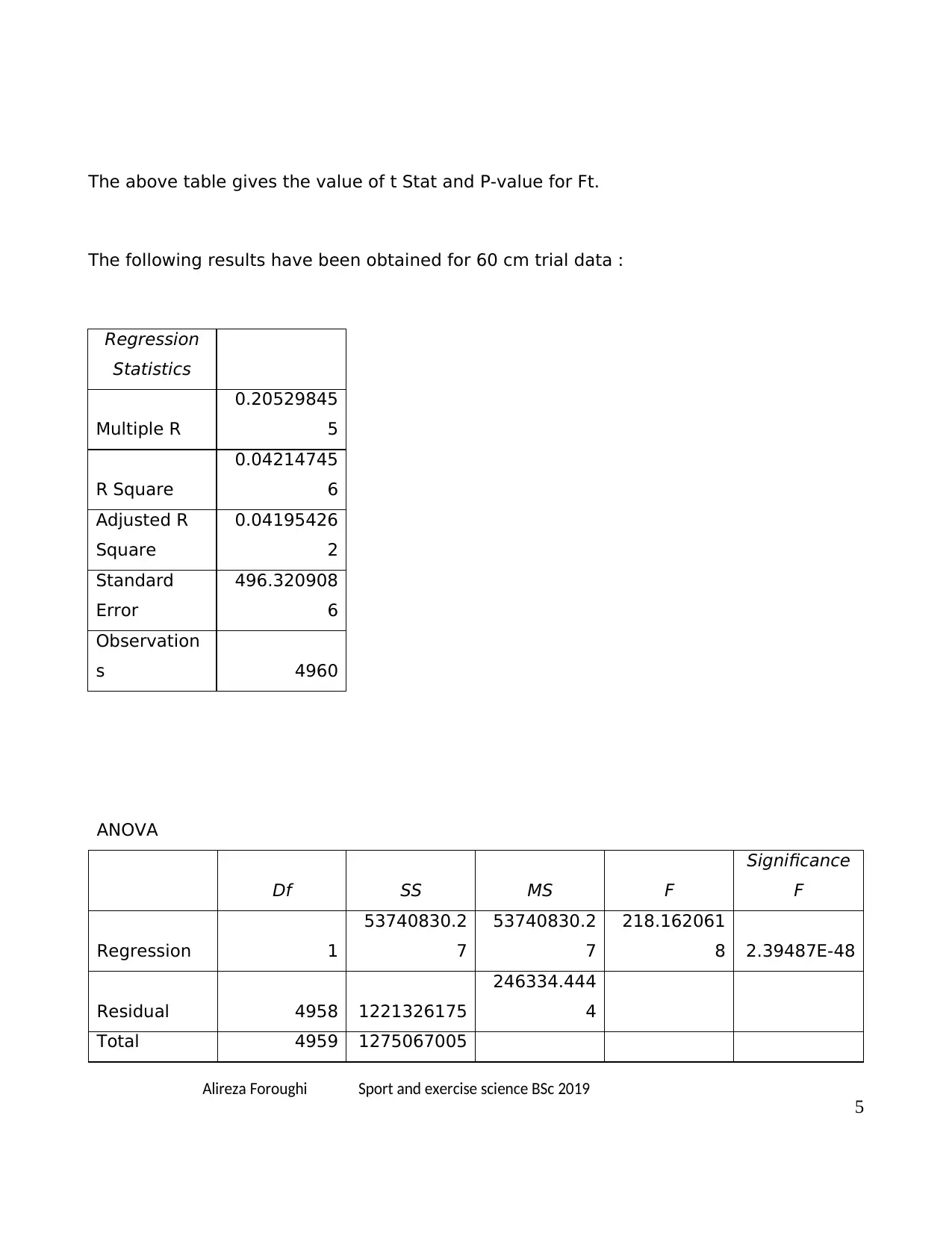
The above table gives the value of t Stat and P-value for Ft.
The following results have been obtained for 60 cm trial data :
Regression
Statistics
Multiple R
0.20529845
5
R Square
0.04214745
6
Adjusted R
Square
0.04195426
2
Standard
Error
496.320908
6
Observation
s 4960
ANOVA
Df SS MS F
Significance
F
Regression 1
53740830.2
7
53740830.2
7
218.162061
8 2.39487E-48
Residual 4958 1221326175
246334.444
4
Total 4959 1275067005
Alireza Foroughi Sport and exercise science BSc 2019
5
The following results have been obtained for 60 cm trial data :
Regression
Statistics
Multiple R
0.20529845
5
R Square
0.04214745
6
Adjusted R
Square
0.04195426
2
Standard
Error
496.320908
6
Observation
s 4960
ANOVA
Df SS MS F
Significance
F
Regression 1
53740830.2
7
53740830.2
7
218.162061
8 2.39487E-48
Residual 4958 1221326175
246334.444
4
Total 4959 1275067005
Alireza Foroughi Sport and exercise science BSc 2019
5
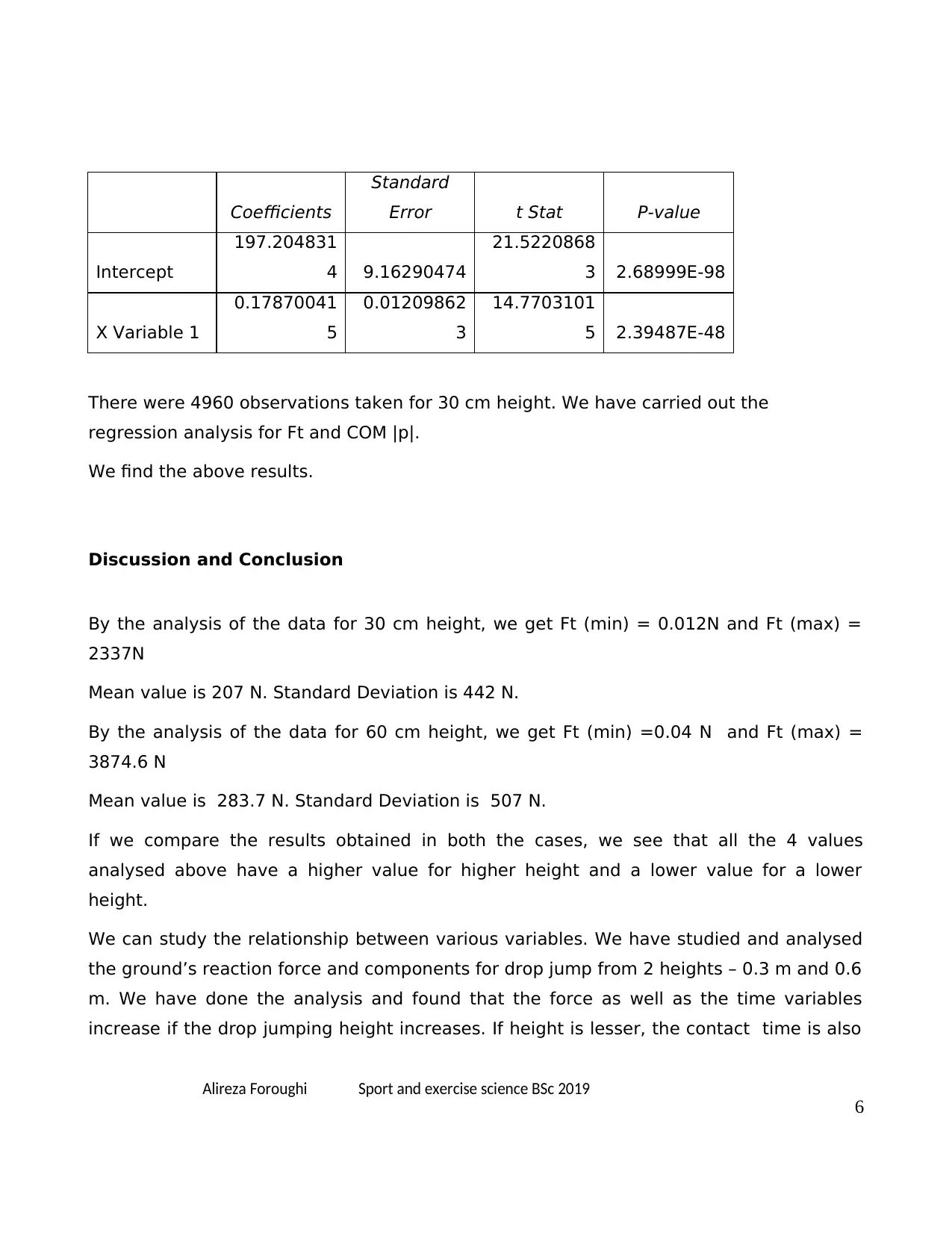
Coefficients
Standard
Error t Stat P-value
Intercept
197.204831
4 9.16290474
21.5220868
3 2.68999E-98
X Variable 1
0.17870041
5
0.01209862
3
14.7703101
5 2.39487E-48
There were 4960 observations taken for 30 cm height. We have carried out the
regression analysis for Ft and COM |p|.
We find the above results.
Discussion and Conclusion
By the analysis of the data for 30 cm height, we get Ft (min) = 0.012N and Ft (max) =
2337N
Mean value is 207 N. Standard Deviation is 442 N.
By the analysis of the data for 60 cm height, we get Ft (min) =0.04 N and Ft (max) =
3874.6 N
Mean value is 283.7 N. Standard Deviation is 507 N.
If we compare the results obtained in both the cases, we see that all the 4 values
analysed above have a higher value for higher height and a lower value for a lower
height.
We can study the relationship between various variables. We have studied and analysed
the ground’s reaction force and components for drop jump from 2 heights – 0.3 m and 0.6
m. We have done the analysis and found that the force as well as the time variables
increase if the drop jumping height increases. If height is lesser, the contact time is also
Alireza Foroughi Sport and exercise science BSc 2019
6
Standard
Error t Stat P-value
Intercept
197.204831
4 9.16290474
21.5220868
3 2.68999E-98
X Variable 1
0.17870041
5
0.01209862
3
14.7703101
5 2.39487E-48
There were 4960 observations taken for 30 cm height. We have carried out the
regression analysis for Ft and COM |p|.
We find the above results.
Discussion and Conclusion
By the analysis of the data for 30 cm height, we get Ft (min) = 0.012N and Ft (max) =
2337N
Mean value is 207 N. Standard Deviation is 442 N.
By the analysis of the data for 60 cm height, we get Ft (min) =0.04 N and Ft (max) =
3874.6 N
Mean value is 283.7 N. Standard Deviation is 507 N.
If we compare the results obtained in both the cases, we see that all the 4 values
analysed above have a higher value for higher height and a lower value for a lower
height.
We can study the relationship between various variables. We have studied and analysed
the ground’s reaction force and components for drop jump from 2 heights – 0.3 m and 0.6
m. We have done the analysis and found that the force as well as the time variables
increase if the drop jumping height increases. If height is lesser, the contact time is also
Alireza Foroughi Sport and exercise science BSc 2019
6
⊘ This is a preview!⊘
Do you want full access?
Subscribe today to unlock all pages.

Trusted by 1+ million students worldwide
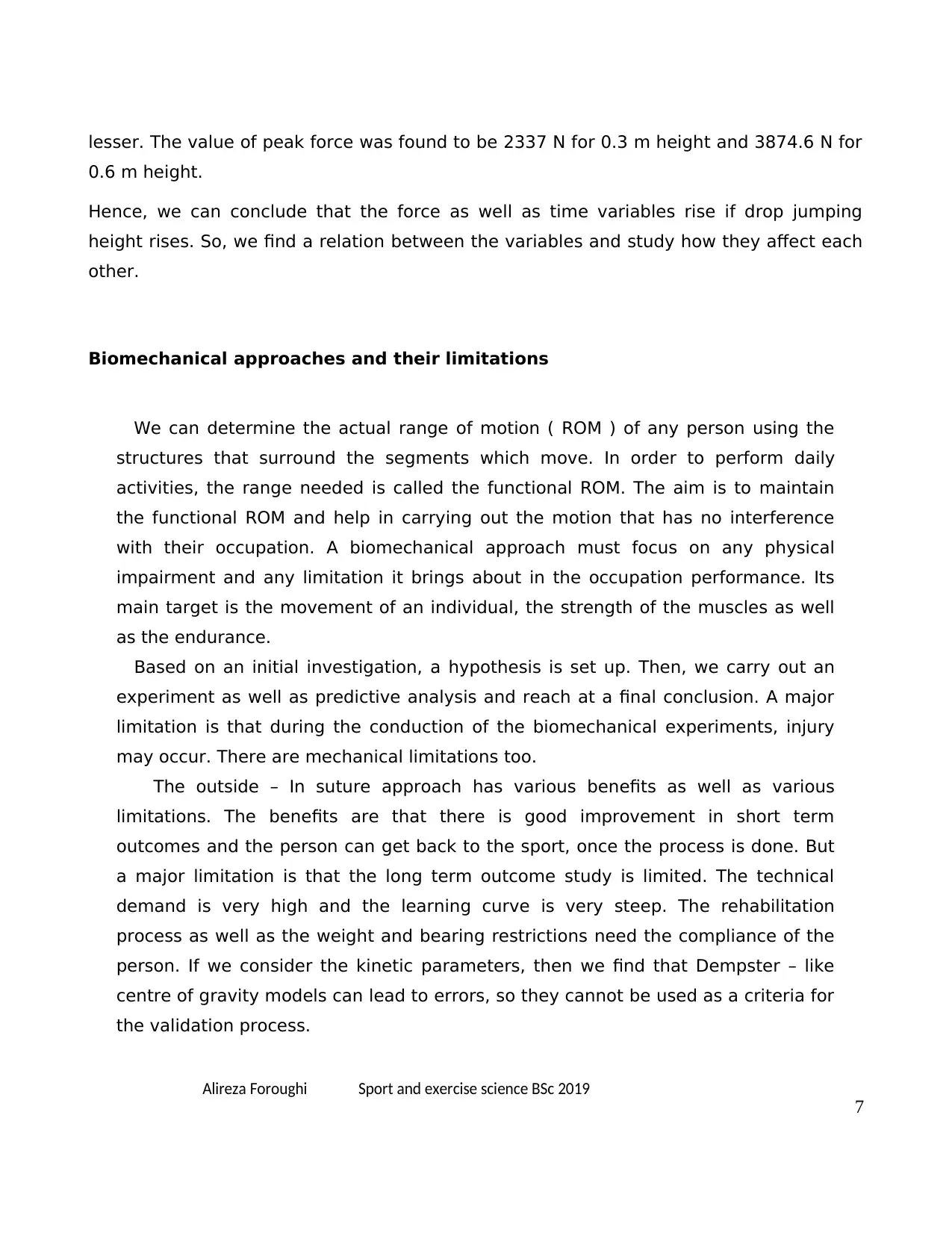
lesser. The value of peak force was found to be 2337 N for 0.3 m height and 3874.6 N for
0.6 m height.
Hence, we can conclude that the force as well as time variables rise if drop jumping
height rises. So, we find a relation between the variables and study how they affect each
other.
Biomechanical approaches and their limitations
We can determine the actual range of motion ( ROM ) of any person using the
structures that surround the segments which move. In order to perform daily
activities, the range needed is called the functional ROM. The aim is to maintain
the functional ROM and help in carrying out the motion that has no interference
with their occupation. A biomechanical approach must focus on any physical
impairment and any limitation it brings about in the occupation performance. Its
main target is the movement of an individual, the strength of the muscles as well
as the endurance.
Based on an initial investigation, a hypothesis is set up. Then, we carry out an
experiment as well as predictive analysis and reach at a final conclusion. A major
limitation is that during the conduction of the biomechanical experiments, injury
may occur. There are mechanical limitations too.
The outside – In suture approach has various benefits as well as various
limitations. The benefits are that there is good improvement in short term
outcomes and the person can get back to the sport, once the process is done. But
a major limitation is that the long term outcome study is limited. The technical
demand is very high and the learning curve is very steep. The rehabilitation
process as well as the weight and bearing restrictions need the compliance of the
person. If we consider the kinetic parameters, then we find that Dempster – like
centre of gravity models can lead to errors, so they cannot be used as a criteria for
the validation process.
Alireza Foroughi Sport and exercise science BSc 2019
7
0.6 m height.
Hence, we can conclude that the force as well as time variables rise if drop jumping
height rises. So, we find a relation between the variables and study how they affect each
other.
Biomechanical approaches and their limitations
We can determine the actual range of motion ( ROM ) of any person using the
structures that surround the segments which move. In order to perform daily
activities, the range needed is called the functional ROM. The aim is to maintain
the functional ROM and help in carrying out the motion that has no interference
with their occupation. A biomechanical approach must focus on any physical
impairment and any limitation it brings about in the occupation performance. Its
main target is the movement of an individual, the strength of the muscles as well
as the endurance.
Based on an initial investigation, a hypothesis is set up. Then, we carry out an
experiment as well as predictive analysis and reach at a final conclusion. A major
limitation is that during the conduction of the biomechanical experiments, injury
may occur. There are mechanical limitations too.
The outside – In suture approach has various benefits as well as various
limitations. The benefits are that there is good improvement in short term
outcomes and the person can get back to the sport, once the process is done. But
a major limitation is that the long term outcome study is limited. The technical
demand is very high and the learning curve is very steep. The rehabilitation
process as well as the weight and bearing restrictions need the compliance of the
person. If we consider the kinetic parameters, then we find that Dempster – like
centre of gravity models can lead to errors, so they cannot be used as a criteria for
the validation process.
Alireza Foroughi Sport and exercise science BSc 2019
7
Paraphrase This Document
Need a fresh take? Get an instant paraphrase of this document with our AI Paraphraser
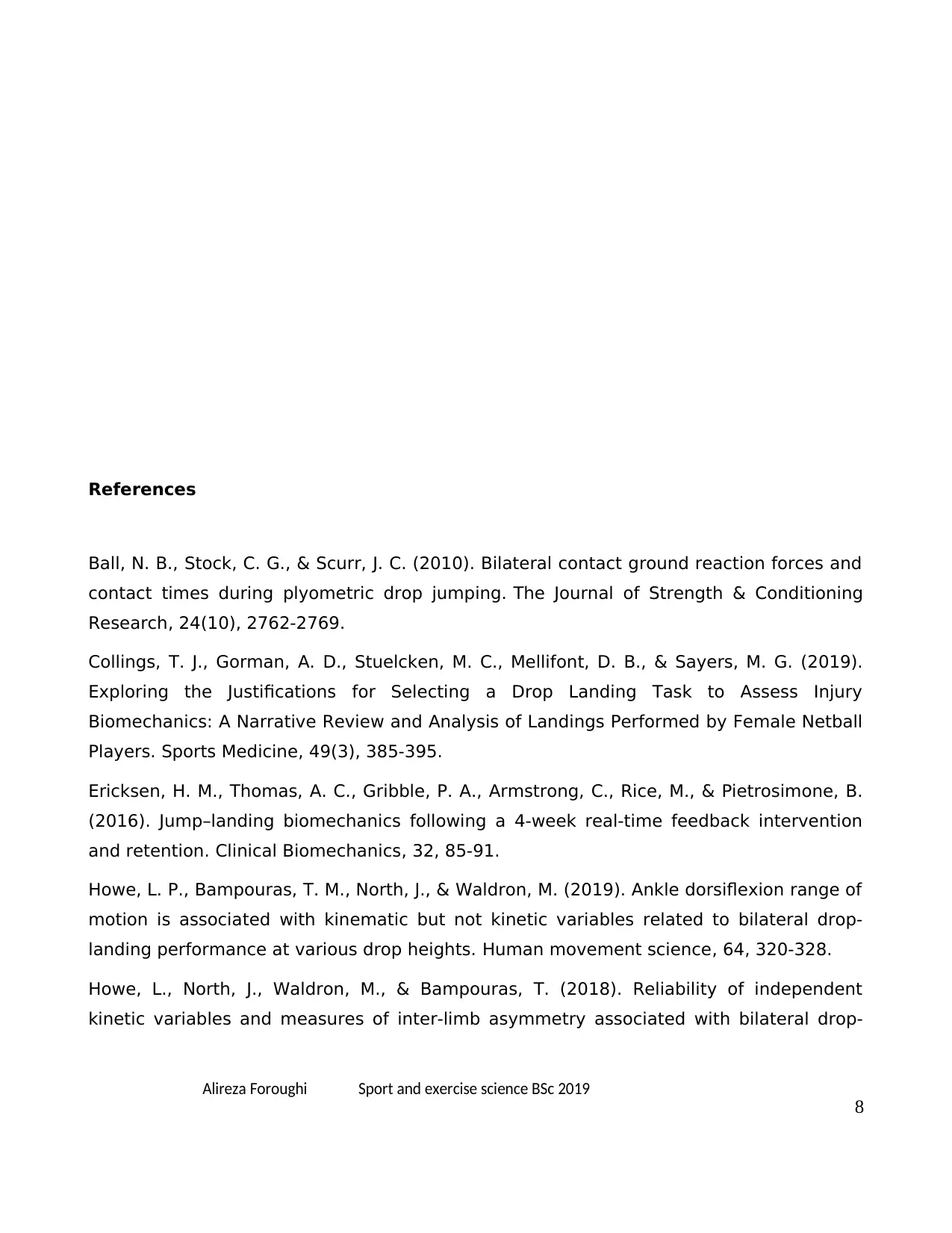
References
Ball, N. B., Stock, C. G., & Scurr, J. C. (2010). Bilateral contact ground reaction forces and
contact times during plyometric drop jumping. The Journal of Strength & Conditioning
Research, 24(10), 2762-2769.
Collings, T. J., Gorman, A. D., Stuelcken, M. C., Mellifont, D. B., & Sayers, M. G. (2019).
Exploring the Justifications for Selecting a Drop Landing Task to Assess Injury
Biomechanics: A Narrative Review and Analysis of Landings Performed by Female Netball
Players. Sports Medicine, 49(3), 385-395.
Ericksen, H. M., Thomas, A. C., Gribble, P. A., Armstrong, C., Rice, M., & Pietrosimone, B.
(2016). Jump–landing biomechanics following a 4-week real-time feedback intervention
and retention. Clinical Biomechanics, 32, 85-91.
Howe, L. P., Bampouras, T. M., North, J., & Waldron, M. (2019). Ankle dorsiflexion range of
motion is associated with kinematic but not kinetic variables related to bilateral drop-
landing performance at various drop heights. Human movement science, 64, 320-328.
Howe, L., North, J., Waldron, M., & Bampouras, T. (2018). Reliability of independent
kinetic variables and measures of inter-limb asymmetry associated with bilateral drop-
Alireza Foroughi Sport and exercise science BSc 2019
8
Ball, N. B., Stock, C. G., & Scurr, J. C. (2010). Bilateral contact ground reaction forces and
contact times during plyometric drop jumping. The Journal of Strength & Conditioning
Research, 24(10), 2762-2769.
Collings, T. J., Gorman, A. D., Stuelcken, M. C., Mellifont, D. B., & Sayers, M. G. (2019).
Exploring the Justifications for Selecting a Drop Landing Task to Assess Injury
Biomechanics: A Narrative Review and Analysis of Landings Performed by Female Netball
Players. Sports Medicine, 49(3), 385-395.
Ericksen, H. M., Thomas, A. C., Gribble, P. A., Armstrong, C., Rice, M., & Pietrosimone, B.
(2016). Jump–landing biomechanics following a 4-week real-time feedback intervention
and retention. Clinical Biomechanics, 32, 85-91.
Howe, L. P., Bampouras, T. M., North, J., & Waldron, M. (2019). Ankle dorsiflexion range of
motion is associated with kinematic but not kinetic variables related to bilateral drop-
landing performance at various drop heights. Human movement science, 64, 320-328.
Howe, L., North, J., Waldron, M., & Bampouras, T. (2018). Reliability of independent
kinetic variables and measures of inter-limb asymmetry associated with bilateral drop-
Alireza Foroughi Sport and exercise science BSc 2019
8
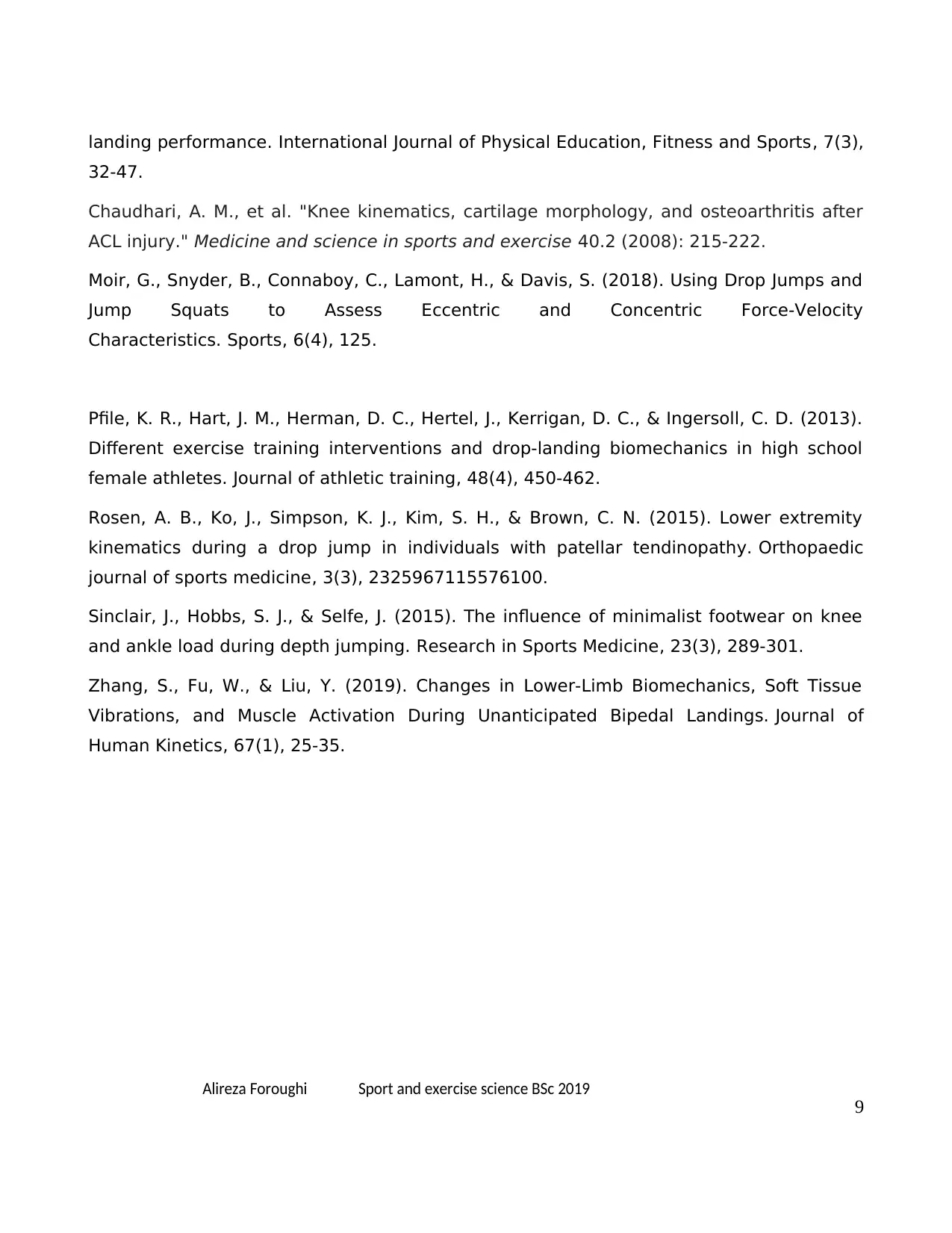
landing performance. International Journal of Physical Education, Fitness and Sports, 7(3),
32-47.
Chaudhari, A. M., et al. "Knee kinematics, cartilage morphology, and osteoarthritis after
ACL injury." Medicine and science in sports and exercise 40.2 (2008): 215-222.
Moir, G., Snyder, B., Connaboy, C., Lamont, H., & Davis, S. (2018). Using Drop Jumps and
Jump Squats to Assess Eccentric and Concentric Force-Velocity
Characteristics. Sports, 6(4), 125.
Pfile, K. R., Hart, J. M., Herman, D. C., Hertel, J., Kerrigan, D. C., & Ingersoll, C. D. (2013).
Different exercise training interventions and drop-landing biomechanics in high school
female athletes. Journal of athletic training, 48(4), 450-462.
Rosen, A. B., Ko, J., Simpson, K. J., Kim, S. H., & Brown, C. N. (2015). Lower extremity
kinematics during a drop jump in individuals with patellar tendinopathy. Orthopaedic
journal of sports medicine, 3(3), 2325967115576100.
Sinclair, J., Hobbs, S. J., & Selfe, J. (2015). The influence of minimalist footwear on knee
and ankle load during depth jumping. Research in Sports Medicine, 23(3), 289-301.
Zhang, S., Fu, W., & Liu, Y. (2019). Changes in Lower-Limb Biomechanics, Soft Tissue
Vibrations, and Muscle Activation During Unanticipated Bipedal Landings. Journal of
Human Kinetics, 67(1), 25-35.
Alireza Foroughi Sport and exercise science BSc 2019
9
32-47.
Chaudhari, A. M., et al. "Knee kinematics, cartilage morphology, and osteoarthritis after
ACL injury." Medicine and science in sports and exercise 40.2 (2008): 215-222.
Moir, G., Snyder, B., Connaboy, C., Lamont, H., & Davis, S. (2018). Using Drop Jumps and
Jump Squats to Assess Eccentric and Concentric Force-Velocity
Characteristics. Sports, 6(4), 125.
Pfile, K. R., Hart, J. M., Herman, D. C., Hertel, J., Kerrigan, D. C., & Ingersoll, C. D. (2013).
Different exercise training interventions and drop-landing biomechanics in high school
female athletes. Journal of athletic training, 48(4), 450-462.
Rosen, A. B., Ko, J., Simpson, K. J., Kim, S. H., & Brown, C. N. (2015). Lower extremity
kinematics during a drop jump in individuals with patellar tendinopathy. Orthopaedic
journal of sports medicine, 3(3), 2325967115576100.
Sinclair, J., Hobbs, S. J., & Selfe, J. (2015). The influence of minimalist footwear on knee
and ankle load during depth jumping. Research in Sports Medicine, 23(3), 289-301.
Zhang, S., Fu, W., & Liu, Y. (2019). Changes in Lower-Limb Biomechanics, Soft Tissue
Vibrations, and Muscle Activation During Unanticipated Bipedal Landings. Journal of
Human Kinetics, 67(1), 25-35.
Alireza Foroughi Sport and exercise science BSc 2019
9
⊘ This is a preview!⊘
Do you want full access?
Subscribe today to unlock all pages.

Trusted by 1+ million students worldwide
1 out of 9
Your All-in-One AI-Powered Toolkit for Academic Success.
+13062052269
info@desklib.com
Available 24*7 on WhatsApp / Email
![[object Object]](/_next/static/media/star-bottom.7253800d.svg)
Unlock your academic potential
Copyright © 2020–2025 A2Z Services. All Rights Reserved. Developed and managed by ZUCOL.
